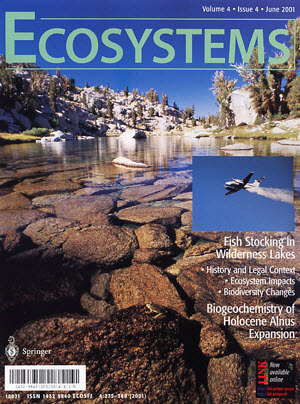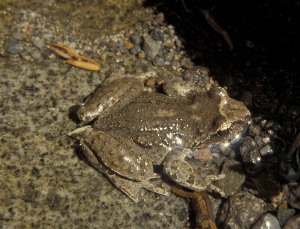Search ARMI Database
Search term(s)
Contribution Number
Search Results
876 record(s) found.
Papers & Reports The introduction of nonnative fish into wilderness lakes: good intentions, conflicting mandates, and unintended consequences
Authors: Roland A Knapp; P. Stephen Corn; D E Schindler
Date: 2001 | Outlet: Ecosystems 4: 275–278
Collectively, these papers indicate that the effects of widespread trout introductions into wilderness landscapes are not limited simply to direct effects on prey taxa, but instead can be transmitted throughout lake food webs and even beyond the shorelines of fish-containing lakes to fishless lakes. In addition, following fish removal, full recovery of ecosystem structure and function may not occur. These results pose a difficult challenge for fisheries and wilderness managers interested in better balancing the conflicting goals of maintaining nonnative fisheries in wilderness areas while also minimizing the effects of these fisheries on natural processes. If managers are to truly balance these often opposing goals, it is imperative that current fisheries management practices be evaluated in the context of their effects on ecosystem and landscape processes. It is our hope that this special feature will provide the impetus for such an evaluation and for the adoption of new management strategies to reduce the ecological impacts of nonnative fisheries in protected areas.
Papers & Reports Quantitative PCR detection of Batrachochytrium dendrobatidis DNA from sediments and water: Diseases of Aquatic Organisms
Authors: Julie A Kirshtein; Chauncey W Anderson; J S Wood; J E Longcore; M A Voytek
Date: 2007 | Outlet: Diseases of Aquatic Organisms 77: 11-15
The fungal pathogen Batrachochytrium dendrobatidis (Bd) causes chytridiomycosis, a disease implicated in amphibian declines on 5 continents. We developed filtering and PCR based quantiative methods to detect Bd in water and sediments. Our methods provide a new tool to investigate critical aspects of Bd in the environment.
Papers & Reports Taxonomic variation in oviposition by tailed frogs (Ascaphus spp.)
Authors: N E Karraker; David S Pilliod; Michael J Adams; Evelyn L Bull; P. Stephen Corn; L V Diller; L A Dupuis; Marc P Hayes; Blake R Hossack; G R Hodgson; E J Hyde; K Lohman; B R Norman; Lisa M Ollivier; Christopher A Pearl
Date: 2006 | Outlet: Northwestern Naturalist 87: 87-97
Tailed frogs (Ascaphus spp.) oviposit in cryptic locations in streams of the Pacific Northwest and Rocky Mountains. This aspect of their life history has restricted our understanding of their reproductive ecology. The recent split of A. montanus in the Rocky Mountains from A. truei was based on molecular differentiation, and comparisons of their ecology are limited. Our objectives were to provide a range-wide summary of information on Ascaphus oviposition,compare some aspects of the reproductive ecology of the 2 species, and examine geographic variation in their reproductive traits. Reproductive ecology of the 2 species differed. Ascaphus truei had smaller clutches, oviposited later in the summer, and had a longer duration of oviposition than A. montanus. A greater number of communal oviposition sites were attributed to A. montanus. These ecological differences support the recent taxonomic revision of Ascaphus and suggest that different management strategies may be necessary for each species where conservation is a priority.
Papers & Reports Impacts of road deicing salt on the demography of vernal pool-breeding amphibians
Authors: N E Karraker; J P Gibbs; J R Vonesh
Date: 2008 | Outlet: Ecological Applications 18: 724-734
Papers & Reports Are embryonic and larval Green frogs (Rana clamitans) insensitive to road deicing salt?
Authors: N E Karraker
Date: 2007 | Outlet: Herpetological Conservation and Biology 2: 35-41
Papers & Reports Geographic distribution – Ambystoma laterale (Blue-spotted Salamander)
Authors: J M Kapfer; J R Parmalee
Date: 2001 | Outlet: Herpetological Review 32: 267
Papers & Reports Plethodon cinereus (Redback Salamander). Predation.
Authors: R E Jung; W L Ward; C O King; L A Weir
Date: 2000 | Outlet: Herpetological Review 31: 98-99
Papers & Reports Estimation of stream salamander (Plethodontidae, Desmognathinae, and Plethodontinae) populations in Shenandoah National Park, Virginia, USA
Authors: R E Jung; J A Royle; J R Sauer; C Addison; R D Rau; J L Shirk; J C Whissel
Date: 2005 | Outlet: Alytes 22: 72-84
Papers & Reports Evaluation of terrestrial and streamside salamander monitoring techniques at Shenandoah National Park
Authors: R E Jung; S Droege; J R Sauer; R B Landy
Date: 2000 | Outlet: Environmental Monitoring and Assessment 63: 65-79
Papers & Reports An evaluation of population index and estimation techniques for tadpoles in desert pools
Authors: R E Jung; G H Dayton; S J Williamson; J R Sauer; S Droege
Date: 2002 | Outlet: Journal of Herpetology 36: 465-472
Papers & Reports Eleutherodactylus guttilatus (spotted chirping frog), Bufo punctatus (red-spotted toad), Hyla arenicolor (canyon tree frog), and Rana berlandieri (Rio Grande leopard frog). Mite infestation.
Authors: R E Jung; S Claeson; J E Wallace; W C Welbourn
Date: 2001 | Outlet: Herpetological Review 32: 33-34
Papers & Reports Evaluation of canoe surveys for anurans along the Rio Grande in Big Bend National Park, Texas.
Authors: R E Jung; Kevin E Bonine; M L Rosenshield; l a de; S Raimondo; S Droege
Date: 2002 | Outlet: Journal of Herpetology 36: 390-397
Papers & Reports Cannibalism and predation by western toad (Bufo boreas) larvae in Oregon, USA
Authors: D J Jordan; C J Rombough; Christopher A Pearl; Brome McCreary
Date: 2004 | Outlet: Western North American Naturalist 64: 403-405
Papers & Reports Surface-water microlayer sampler used at frog-malformation sites
Authors: P M Jones; M A Menheer
Date: 2002 | Outlet: WRD Instrument News 96: 1-6
Papers & Reports Geographic distribution – Osteopilus septentrionalis (Cuban Treefrog)
Authors: S A Johnson; J S Staiger; William J Barichivich; S Barlow
Date: 2003 | Outlet: Herpetological Review 34: 381
Natural history note
Papers & Reports Geographic distribution – Eleutherodactylus planirostris (Greenhouse Frog)
Authors: S A Johnson; J S Staiger; William J Barichivich
Date: 2003 | Outlet: Herpetological Review 34: 161
Note
Papers & Reports A simple technique for trapping Siren lacertina, Amphiuma means, and other aquatic vertebrates
Authors: S A Johnson; William J Barichivich
Date: 2004 | Outlet: Journal of Freshwater Ecology 19: 263-269
We describe a commercially-available funnel trap for sampling aquatic vertebrates. The traps can be used in heavily vegetated wetlands and can be set in water up to 60 cm deep without concern for drowning the animals. They were especially useful for capturing the aquatic salamanders Siren lacertina and Amphiuma means, which have been difficult to capture with traditional sampling methods. They were also effective for sampling small fishes, particularly centrachids, and larval anurans. In total, 14 species of amphibians, nine species of aquatic reptiles, and at least 32 fish species were captured. The trap we describe differs significantly from funnel traps (e.g., minnow traps) and holds great promise for studies of small, aquatic vertebrates, in particular Siren and Amphiuma species.
Papers & Reports Orientation and migration distances of a pond-breeding salamander (Notophthalmus perstriatus, Salamandridae)
Authors: S A Johnson
Date: 2003 | Outlet: Alytes 21: 3-22
Habitat loss and modification have played a significant role in the decline of amphibian populations and species. Loss of wetlands, which are used as breeding sites for many amphibians, has contributed to the decline. The protection of small, isolated wetlands and core areas of associated uplands is one way in which population declines in certain species can be slowed or prevented. Nevertheless, migration distances of individuals of most amphibian species from their breeding sites are unknown. Using drift fences and pitfall traps, I studied migration distance and orientation of striped newts (Notophthalmus perstriatus) at a breeding pond in northern Florida, USA. Newts entered (immigration) and exited (emigration) the pond basin in a nonrandom fashion but no obvious effects of upland habitat were apparent. Patterns of emigration and immigration differed significantly between sexes, life-history stages, and migration events. Individuals tended to exit and enter the pond basin within the same quadrant, sometimes leaving and returning at the same point. Newts moved hundreds of meters into the sandhill uplands surrounding the pond. I found an inverse relationship between the proportion of newts migrating and distance from the pond. Nonetheless, I estimated that at least 16 % of individuals breeding at the pond migrated in excess of 500 m from the pond. Thus, a core of protected upland with a radius of approximately 800 m from the pond would be needed to preserve the area used by the vast majority of individuals that breed at the pond. These data underscore the need to study upland habitat requirements for amphibians; findings for one taxon (e.g. ambystomatids) may not be applicable to others (e.g., salamandrids). Without such data, designating terrestrial core habitat to conserve aquatic-breeding amphibians will be difficult or impossible. However, without better protection of small, isolated wetlands, arguments to preserve surrounding uplands are irrelevant.
Papers & Reports Life history of the striped newt at a north-central Florida breeding pond
Authors: S A Johnson
Date: 2002 | Outlet: Southeastern Naturalist 4: 381-402
I studied the life history of Striped Newts (Notophthalmus perstriatus) at a breeding pond in north-central Florida. Newts were captured in pitfall traps at a drift-fence as they migrated into and out of the pond basin. During the 2-year study, I recorded 10,290 captures (8,127 individuals) of newts at the drift-fence. Newts were active during each month of the study, but there were four peak activity periods, each of which included immigration and emigration events. Immigration events were almost exclusively comprised of adults, whereas emigration events were comprised of adults and recently transformed larvae. I documented 5,296 recently transformed, immature larvae (efts) and 435 recently transformed mature larvae (paedomorphs) during four distinct periods of emigration. Efts matured in the uplands before returning to the pond to breed. In the uplands, male efts (n = 16) grew 0.0183 mm/day on average, whereas average female (n = 24) growth was 0.0167 mm/day. Immigrating adults of both sexes were significantly smaller than emigrating adults. Emigrating efts were smallest, followed by emigrating paedomorphs, immigrating adults, then emigrating adults. The overall adult sex ratio was 1:https://1.25 (m:f). Sex ratio of emigrating paedomorphs was highly skewed towards females, with one male for every https://4.43 females. Newts tended to move during wetter periods, and captures were significantly correlated with rainfall, but rainfall was a poor predictor of the magnitude of newt movements.
Papers & Reports Parasite (Ribeiroia Ondatrae) infection linked to amphibian malformations in the western United States
Authors: P TJ Johnson; K B Lunde; E M Thurman; E G Ritchie; S N Wray; D R Sutherland; J M Kapfer; T J Fest; Jay Bowerman; Andrew R Blaustein
Date: 2002 | Outlet: Ecological Monographs 72(2): 151-168


